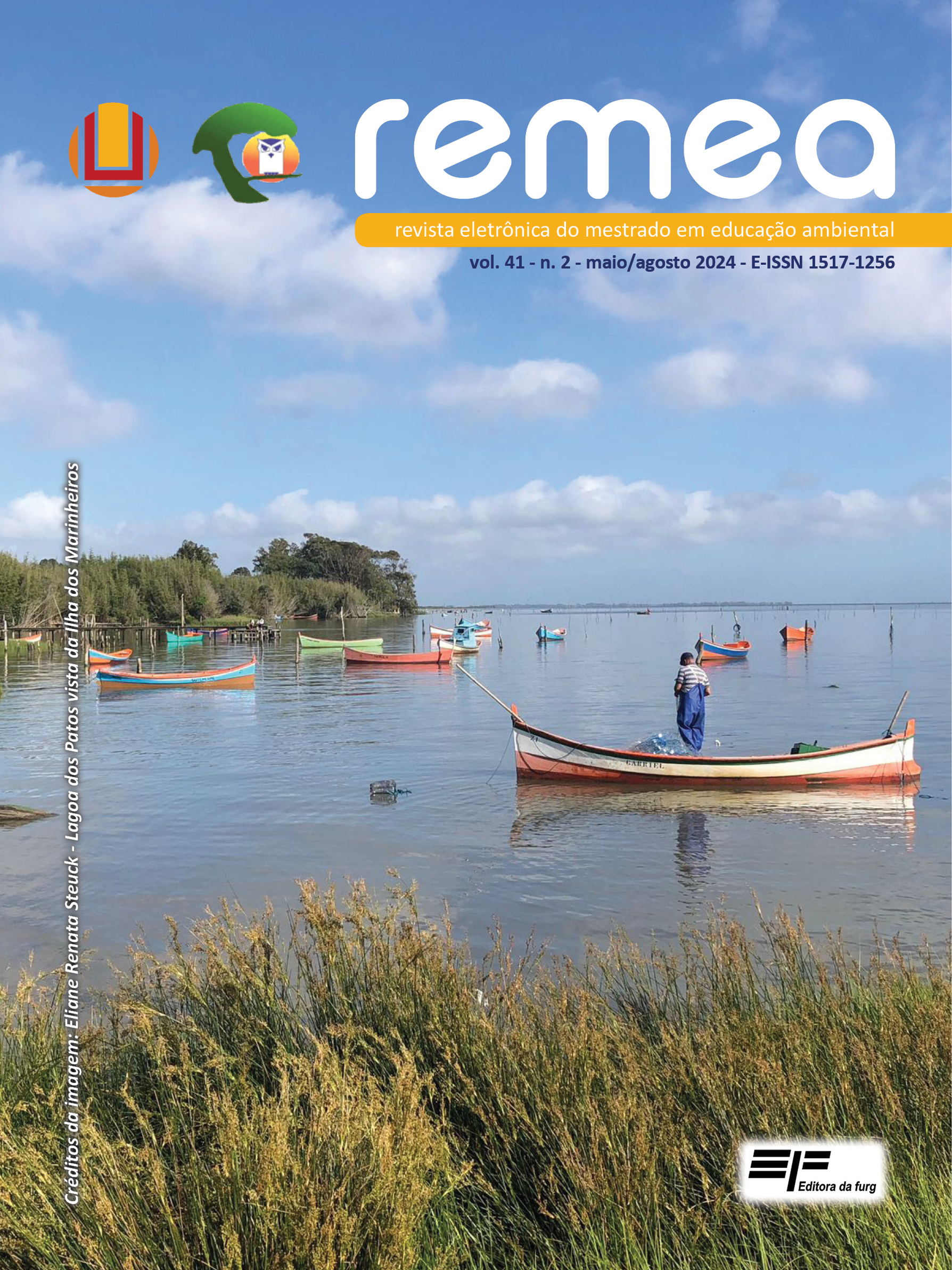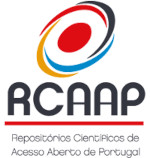“Invisible” communities of rivers: an environmental education workshop on benthonic invertebrates
uma oficina de educação ambiental sobre invertebrados bentônicos
DOI:
https://doi.org/10.14295/remea.v41i2.16229Keywords:
Bioindicators, Science education, Bioinspired educationAbstract
The aim of this study was to evaluate the knowledge of students in the elementary school about benthic invertebrates (BI) of rivers. We collected data through questionnaires and observed students' interactions and comments. The results highlight a low understanding of BI compared to knowledge about other life forms in the Macaé River. Additionally, students demonstrated significant confusion in discerning which animals inhabit freshwater or marine environments. Moreover, the students showed a high level of acceptance regarding the workshop, expressing particular interest sparked by their curiosity about BI.
Downloads
References
A PEQUENA SEREIA. Creator and executive produced by Hans Christian Andersen. Executive Producer: John Musker Howard Ashman, California, Walt Disney Feature Animation, 1989. (82 min).
ALMEIDA, Luiz Fernando Rolim; BICUDO, Luiz Roberto Hernandes; BORGES, Gilberto Luiz de Azevedo. Educação ambiental na Praça Rubião Júnior, Botucatu– SP. Botucatu, SP. 2000. 85p. Originalmente apresentada como monografia de conclusão de curso, Instituto de Biociências, Universidade Estadual Paulista, Botucatu, 2000.
AMARAL, Kelly Oliveira do; MEDEIROS, Miguel de Araújo. Análise das concepções de estudantes do Ensino Fundamental sobre insetos, por meio da metodologia do Discurso do Sujeito Coletivo. Brazilian Geographical Journal, Ituiutaba, v. 6, n. 1, p. 156–180, 2015. Disponível em: https://seer.ufu.br/index.php/braziliangeojournal/article/view/28068.
ARAÚJO, Sergio Wilson de; TEIXEIRA, Flávia Tavares Vieira. Educação Ambiental e Tecnologias: Ensino e Aprendizado sobre Biomonitoramento e sua importância para a preservação das águas por meio de Vídeo Educacional – Relato de Experiências. Revista Vozes dos Vales, v. 16, p. 1-39. 2019.
ASSUMPÇÃO, André Polly; MARÇAL, Mônica dos Santos. Retificação dos canais fluviais e mudanças geomorfológicas na planície do Rio Macaé (RJ). Revista de Geografia, v.29(3), p.19-36. 2012.
BALLOUARD, Jean-Marie; PROVOST, Gregory; BARRÉ, Daniel; BONNET, Xavier. Influence of a Field Trip on the Attitude of Schoolchildren toward Unpopular Organisms: An Experience with Snakes. Journal of Herpetology, v. 46(3), p. 423-428. 2012 DOI: https://doi.org/10.1670/11-118
BOB ESPONJA. Creator and producer Stephen Hillenburg. Executive Producer: Stephen Hillenburg. California, Nickelodeon Animation Studios United Plankton Pictures, 1999.
BROOKES, Andrew. Channelized Rivers: Perspectives for environmental management. Chichester: Wiley. 1988. 326p.
CALLISTO, Marcos; GONÇALVES JÚNIOR, José Francisco; MORENO, Pablo. Invertebrados aquáticos como bioindicadores. 2005. Disponível em: <https://manuelzao.ufmg.br/wp-content/uploads/2018/08/invertaquaticos.pdf>. Acesso em: 19 de agosto de 2023.
CALLISTO, Marcos; MORETTI, Marcelo da Silva; GOULART, Michael Dave Cançado. Macroinvertebrados Bentônicos como Ferramenta para Avaliar a Saúde de Riachos. RBRH - Revista Brasileira de Recursos Hídricos, v. 6, n.1, p 71 – 82, 2001. DOI: https://doi.org/10.21168/rbrh.v6n1.p71-82
CARDOSO, Jaqueline dos Santos; Carvalho, Karine Santana; Teixeira, Paulo Marcelo M. Um estudo sobre a abordagem da Classe Insecta nos livros didáticos de ciências biológicas. SITIENTIBUS série Ciências Biológicas, v. 8(1), p. 80–88. 2008. Disponível em: https://doi.org/10.13102/scb8076. Acesso em: 26 de agosto de 2023. DOI: https://doi.org/10.13102/scb8076
CORRÊA, Vinícius Amaral. Avaliação do tema insetos nos livros didáticos do ensino fundamental. 2012. Monografia (Licenciatura em Ciências Biológicas) - Departamento de Ensino de Ciências e Biologia, Universidade do Estado do Rio de Janeiro. Rio de Janeiro, 2012.
COSTA, Rafael Nogueira. Olhos compostos: um conceito bioinspirado para o campo
educacional. Anais do XIV Encontro Nacional de Pesquisa em Educação em Ciências. Campina Grande: Realize Editora, 2023.
DIETZ, James; DIETZ, Lou Ann.; NAGAGATA, Elizabeth Yoshimi. The effective use of flagship species for conservation of biodiversity: the example of lion tamarins in Brazil. Springer Dordrecht, p. 32–49. 1994. Disponível em: https://rd.springer.com/chapter/10.1007/978-94-011-0721-1_2. Acesso em: 26 agosto de 2023. DOI: https://doi.org/10.1007/978-94-011-0721-1_2
ESTEVES, Francisco de Assis. Fundamentos de Limnologia. Rio de Janeiro: Editora Interciência Ltda, 3.ed. 2011.
FARRAPEIRA, Cristiane Maria Rocha; PINTO, Sthefane Lyra. Práticas e metodologias do ensino de Zoologia. Recife: Universidade Federal Rural de Pernambuco. 48 p. 2005
FISCHER, Marta Luciane; PAROLIN, Lays Cherobim; VIEIRA, Thalita Bastida; GARBADO, Flávia Roberta Amend. Bioética Ambiental e Educação Ambiental: levantando a reflexão a partir da percepção. Revista Brasileira De Educação Ambiental (RevBEA), V. 12(1), p. 58–84. 2017. Disponível em: https://doi.org/10.34024/revbea.2017.v12.2271. Acesso em: 30 agosto de 2023. DOI: https://doi.org/10.34024/revbea.2017.v12.2271
GRUZMAN, Eduardo. Representações dos Insetos através da imagem: uma investigação teórico-prática para a realização de um vídeo educativo em eco-entomologia. 2003. 165 f. Dissertação (mestrado) – UFRJ/NUTES. Programa de Pós-graduação em Tecnologia Educacional nas Ciências da Saúde, Rio de Janeiro, 2003.
GUIMARÃES, Luciana Ribeiro. Série professor em ação: atividades para aulas de Ciências: Ensino Fundamental, 6º ao 9º ano/Luciana Ribeiro Guimarães. 1ª ed. São Paulo: Nova Espiral, 2009.
HEEP, Luiz Ubiratan; RASTELLO, Rozane Maria; MILESI, Silvia Vendruscolo; BIASI, Cristiane; MOLOZZI, Joseline. Distribution of aquatic insects in urban headwater streams. Acta Limnologica Brasiliensia, v.25(1), p 1-9, 2013. DOI: https://doi.org/10.1590/S2179-975X2013005000014
LUCA. Creator and executive produced by Andrea Warren. Executive Producer: Andrea Warren, California, Pixar Animation Studios and Walt Disney Pictures, 2021. (95 min)
MAGALHÃES, Stephanie Freitas Couto; BARBOZA, Carlos Alberto de Moura; MAIA, Mayra Braz; MOLISANI, Mauricio Mussi. Influence of land cover, catchment morphometry and rainfall on water quality and material transport of headwaters and low-order streams of a tropical mountainous watershed. Catena, v. 213, p. 1-11. 2022. https://doi.org/10.1016/j.catena.2022.106137. DOI: https://doi.org/10.1016/j.catena.2022.106137
MEDINA, Naná Minini. A formação dos professores em Educação Ambiental. In: BRASIL. Secretaria de Educação Fundamental. Panorama da educação ambiental no ensino fundamental. Brasília: Ministério da Educação, 2001. Disponível em: http://portal.mec.gov.br/secad/arquivos/pdf/educacaoambiental/panorama.pdf. Acesso em: 20 de agosto de 2023.
MINAYO, Maria Cecília Souza. Pesquisa Social. Teoria, método e criatividade. 14 ed. Petrópolis: Vozes, 1994.
MIRANDA, Juliana Aparecida Souza; FIGUEIREDO, Rodolfo Antônio. Percepção e valores dos insetos no ensino fundamental de escola pública em Araraquara, SP. Anais do V EPEA –Encontro Pesquisa em Educação Ambiental. São Carlos: UFSCar. P.15. 2009. Disponível em: http://www.epea.tmp.br/epea2009_anais/pdfs/plenary/T02.pdf. Acesso em: 12 de setembro de 2023.
KELLER, Edward. Pools, riffles and channelization. Environmental Geology, v.2, p. 119-127. 1978. DOI: https://doi.org/10.1007/BF02380474
LIANZA, Sidney; ADDOR, Felipe. Pesquisa-Ação na cadeia produtiva da pesca em Macaé: Relatório de Pesquisa Contínuo. Porto Alegre: Editora da UFRGS, 2006. 276p.
MODRO, Anna Frida Hatsue; COSTA, Milton Sousa; MAIA, Emanuel; ABURAYA, Fernando Hiroshi. Percepção entomológica por docentes e discentes do município de Santa Cruz do Xingu, Mato Grosso, Brasil. Biotemas, v. 22(2), p. 153-159. 2009. DOI: https://doi.org/10.5007/2175-7925.2009v22n2p153
MOREIRA-CONEGLIAN, Iara Regiane; DINIZ, Renato Eugênio da Silva; BICUDO, Luiz Roberto Hernandes. Educação ambiental em praça pública no município de Botucatu/SP. Revista Ciência em Extensão. v.1, n.1, p.39-52. 2004.
NEIMAN, Z. Tratado de educação ambiental para sociedades sustentáveis e responsabilidade global. Revista Brasileira De Educação Ambiental, Edição Especial, p. 1-6, 2023. https://periodicos.unifesp.br/index.php/revbea/article/view/15517
O ESPANTA TUBARÕES. Creator and executive produced by Rob Letterman. Executive Producer: Bill Damaschke, California, DreamWorks Animation, 2004. (90 min)
POSEY, Darrel Addison. Temas e inquirições em etnoentomologia: algumas sugestões quanto à geração de hipóteses. Boletim do Museu Paraense Emílio Goeldi, Belém. v. 3, n. 2, p. 99-134. 1987.
PROCURANDO NEMO. Creator and executive produced by Andrew Stanton. Executive Producer: Graham Walters, California, Pixar Animation Studios and Walt Disney Pictures 2003. (100 min)
SILVA, José Severino Bento; ANDRADE, Wbneide Martins de; RAMOS, Marcelo Alves; FERRAZ, Elba Maria Nogueira; SOUTO, Wedson Medeiros; ALBUQUERQUE, Ulysses Paulino de; ARAÚJO, Elcida de Lima. Students’ perception of urban and rural environmental protection areas in Pernambuco, Brazil. Rev. Tropical Conservation Science, v. 8. p. 813-827. 2015. DOI: https://doi.org/10.1177/194008291500800316
SILVA, Jones Henrique Carvalho; SILVA-FILHO, Emmanoel; LEITE, Analy; MOLISANI, Mauricio Mussi. Effects of a recent urbanization event on coastal groundwater in the southeastern coast of Brazil: a case study of the Macaé municipality. Brazilian Journal of Environmental Sciences (RBCIAMB), v. 57(1), p. 114–124. 2022. https://doi.org/10.5327/Z2176-94781044. DOI: https://doi.org/10.5327/Z2176-94781044
TAVARES, Alice Ferreira; CAUTIERO, Gisele Muniz dos Santos; FRANCO, Maria da Conceição Vilela. Relatos e personagens na história de Macaé. Macaé, RJ: Solar dos Mellos, 2014.
TRINDADE, Oziel Santana Neri; SILVA JÚNIOR, Juvenal Cordeiro; TEIXEIRA, Paulo Marcelo Marini. Um estudo das representações sociais de estudantes do ensino médio sobre os insetos. Ensaio Pesquisa Em Educação Em Ciências (belo Horizonte), v. 14(3). P. 37–50. 2012. Disponível em: https://doi.org/10.1590/1983-21172012140303. Acesso em: 6 de setembro de 2023. DOI: https://doi.org/10.1590/1983-21172012140303
UNESCO. Década das Nações Unidas da Educação para o Desenvolvimento Sustentável 2005-2014: documento final plano internacional de implementação. Brasília: UNESCO, 2005.
VALE, Denise Pereira; CAMPOS, Letícia Zenóbia de Oliveira. Estudo das representações de paisagem de estudantes de uma zona rural no Oeste da Bahia. Revista Brasileira De Educação Ambiental (RevBEA), São Paulo, v.16(5). P.134–155, 2021. Disponível em: https://doi.org/10.34024/revbea.2021.v16.11186. Acesso em: 18 de setembro de 2023. DOI: https://doi.org/10.34024/revbea.2021.v16.11186
WHYTE, William Foote. Sociedade de esquina: a estrutura social de uma área urbana pobre e degradada. Tradução de Maria Lucia de Oliveira. Rio de Janeiro, Jorge Zahar, 2005.
Downloads
Published
How to Cite
Issue
Section
License

This work is licensed under a Creative Commons Attribution-NonCommercial-ShareAlike 4.0 International License.










